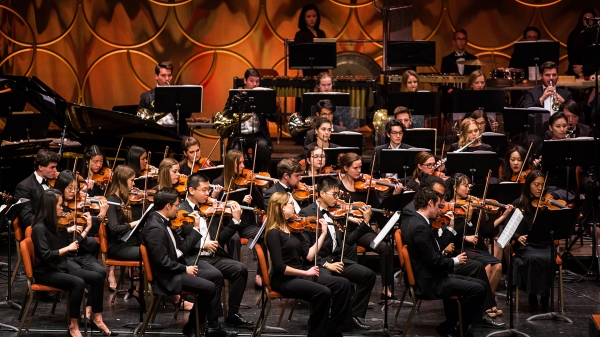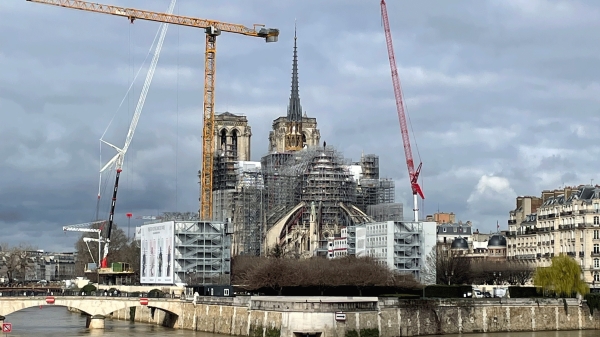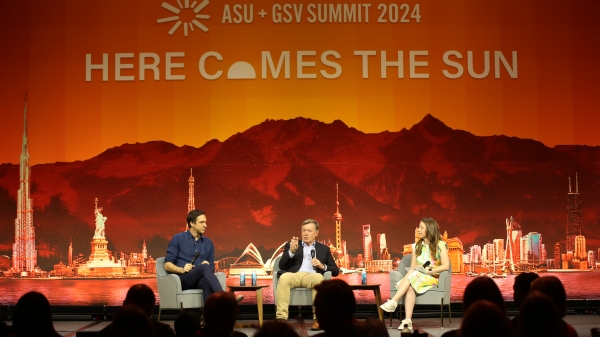Music graduate builds culturally diverse bridges connecting communities

Doctoral graduate Melanie Brooks developed the "Building Bridges Through Music" festival.
Editor’s note: This is part of a series of profiles for spring 2018 commencement.
During the first year of Melanie Brooks’ graduate work as a doctoral student in wind conducting in ASU’s School of Music, it quickly became apparent that she was everything conducting teachers hope for in their students.
“Brooks demonstrates a dedication to refining her craft, a desire to deepen her creative artistry and an unquenchable and multifaceted intellectual curiosity,” said Heather Landes, director of the ASU School of Music. “Consequently, her professional growth was far beyond the norm, her academic achievements were outstanding and her teaching with a diverse array of music students was exemplary.”
That was not enough for Brooks, however.
Inspired by her experiences in Finland during her Fulbright residency, by the work of a few School of Music alums who focus on improving social justice through music with the Harmony Project Phoenix and by the Herberger Institute for Design and the Art’s mission “to position designers, artists, scholars and educators at the center of public life and prepare them to use their creative capacities to advance culture, build community and imaginatively address today’s most pressing challenges,” Brooks, who has been named one of two outstanding graduate students by the Herberger Institute for Design and the Arts, partnered with composers, alumni, community members and School of Music faculty and students to create a body of music designed to build intergenerational and culturally diverse bridges between communities.
This collaboration culminated in side-by-side performances and a recording project of commissioned concertos for beginning instrumentalists with intermediate-to-advanced wind band that involved the ASU Concert Band and the ASU Wind Orchestra and Harmony Project Phoenix students. The Harmony Project students come predominantly from the Phoenix Union High School District, which is 95 percent Latino. The outcome of her work has been recognized by the Arizona Music Educators Association and by the College Band Directors National Association as significant to her field.
Question: What was your “aha” moment, when you realized you wanted to study the field you majored in?
Answer: For the first two years of my undergraduate studies at St. Olaf College, I was double majoring in music and pre-medicine. I was good at math and science, but my passion was always music. During one concert, the St. Olaf Band performed a transcription of “Polovtsian Dances” by Alexander Borodin, a Russian chemist whose passion was composing music. Borodin’s composition gave me the peace of mind that those two fields of study aren't necessarily mutually exclusive. It also gave me the courage to reflect and act on what was most meaningful and enjoyable to me, and music was the clear-cut winner.
Q: What’s something you learned while at ASU — in the classroom or otherwise — that surprised you, that changed your perspective?
A: During the process of developing my doctoral research project and the "Building Bridges Through Music" festival, I was met with many surprises. First, I was happily surprised about how many people were genuinely interested in getting involved with a project designed to empower young students. I expected about 10 to 15 new pieces to come out of this project. From 2016 to 2018, 29 pieces were created for the project by composers from around the world. I expected the festival to involve the Harmony Project Phoenix and one or two ASU ensembles, but the festival grew to include the Harmony Project, the Tijuana-based Ninos de la Guadalupana Villa Del Campo, Brophy College Preparatory School and three ASU ensembles (Wind Orchestra, Wind Ensemble and Philharmonia Orchestra).
Second, I was surprised at how difficult it is to put all of the pieces together and coordinate a project/festival of this scale. Perhaps this is why many people shy away from community engagement and outreach events (it takes a lot of time and effort), but in my opinion the experience is more than worth it. I will gladly take on the mission to connect diverse groups of people in meaningful collaborations as that is one of the most powerful ways to develop understanding, compassion and even creative ideas!
Q: Why did you choose ASU?
A: Several years before beginning my graduate studies, I attended a summer conducting workshop in Colorado. Gary W. Hill, ASU School of Music professor, was one of the clinicians at the workshop, and I found his musicality, creative ideas and research to be incredibly impressive and thought-provoking. After that experience, I knew I wanted to study with him.
Q: What’s the best piece of advice you’d give to those still in school?
A: Don't forget to go outside and play. I have had my best creative ideas when I have been on a trail run or a hike in Phoenix's many mountain trails. Also, being outside in beautiful weather nine months out of the year is a huge perk of living in Arizona.
Q: What was your favorite spot on campus, whether for studying, meeting friends or just thinking about life?
A: I often find myself sneaking away to the ASU Art Museum. There's shade, peace and quiet and interesting architecture with plenty of study nooks.
Q: What are your plans after graduation?
A: I have accepted the director of bands position at Winona State University in Winona, Minnesota. I will teach courses, direct ensembles and continue to pursue commissioning and performance projects focused on community engagement. I am very fortunate to join the Minnesota community again and reconnect with my family, friends and musician colleagues in the area.
Q: If someone gave you $40 million to solve one problem on our planet, what would you tackle?
A: Tangible problem: hunger. Intangible problem: xenophobia.
More Arts, humanities and education

ASU Symphony Orchestra welcomes visionary conductor Jonathan Taylor Rush
Guest conductor Jonathan Taylor Rush will join Arizona State University’s Jason Caslor, director of bands, to lead the ASU…

Chemistry classes are key to art student's success
Amanda Barnette has a passion for art preservation. That means that, for the past four years, the Arizona State University…

ASU+GSV Summit tackles big questions about AI, technology, education
Editor's note: We'll be updating this story daily throughout the summit. The annual ASU+GSV Summit kicked off in San Diego on…